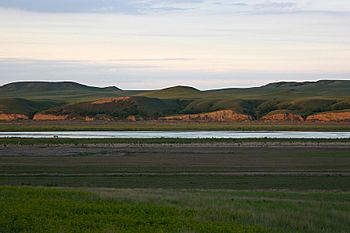Cannonball River facts for kids
Quick facts for kids Cannonball River |
|
|---|---|

The Cannonball River
|
|
| Physical characteristics | |
| Main source | Slope County in White Lake National Wildlife Refuge 2,780 ft (850 m) 46°28′12″N 103°12′24″W / 46.47°N 103.2066667°W |
| River mouth | Confluence with Missouri River in Lake Oahe 1,611 ft (491 m) 46°25′45″N 100°35′21″W / 46.4291667°N 100.5891667°W |
| Length | 135 mi (217 km) |
| Basin features | |
| Progression | Cannonball River → Missouri → Mississippi → Gulf of Mexico |
| GNIS ID | 1035898 |
The Cannonball River (which is called Íŋyaŋwakağapi Wakpá by the Lakota people) is a river in southwestern North Dakota, United States. It flows for about 135 miles (217 km) before joining the mighty Missouri River. This river is known for some interesting round rocks found nearby.
Contents
Discovering the Cannonball River
The Cannonball River is an important waterway in North Dakota. It helps shape the land and provides a home for many plants and animals. Let's explore where it starts and where it goes!
Where the River Begins
The Cannonball River starts in the Little Missouri National Grassland. This area is part of the unique badlands region. You can find its beginning in northern Slope County. This is near a town called Amidon.
Following the River's Journey
From its start, the Cannonball River flows mostly to the southeast. It passes by several towns along its way. These towns include New England, Mott, and Burt.
Later, another stream called Cedar Creek joins the Cannonball River. This happens about 15 miles (24 km) southwest of Shields. After this, the river turns and flows northeast.
It continues past Shields and forms the northern border of Sioux County. It also creates the northern edge of the Standing Rock Indian Reservation. Finally, the Cannonball River flows into the Missouri River. This meeting point is in Lake Oahe, near the town of Cannon Ball.
How the Cannonball River Got Its Name
The river's unique name comes from special rocks found in the area. These rocks are called "cannonball concretions." They are naturally formed, round rocks that look a lot like old cannonballs! These cool rock formations gave the river its memorable name.

